Rural Transformation Development and Its Influencing Factors in China’s Poverty-Stricken Areas: A Case Study of Yanshan-Taihang Mountains
Abstract
1. Introduction
2. Theory and Methodology
2.1. Theoretical Framework
2.2. Research Methods
2.2.1. Measurement of RTD
2.2.2. Pre-Section of Influencing Factors and Model Construction
3. Study Area and Data Sources
3.1. Study Area
3.2. Data Sources and Processing
4. Empirical Results
4.1. Spatio-Temporal Patterns of RTD in Yanshan-Taihang Mountains
4.1.1. Spatio-Temporal Patterns of Quantitative Changes
4.1.2. Spatial and Temporal Patterns of RTD
4.2. Factors Influencing RTD in Yanshan-Taihang Mountains
- (1)
- Average altitude (altitude). Most counties had a negative effect of average elevation on RTD, but only a few counties passed the significance test. Especially in 2020, all counties failed the 10% significance test. The main reason for this was that the development of productivity made the role of natural conditions in RTD insignificant.
- (2)
- Per capita farmland area (farm). In 2000 and 2010, the effect of per capita farmland area on RTD was mainly negative, and the counties in the western Yanshan Mountains and northern Taihang Mountains both passed the significance test. In 2020, the impact of per capita farmland area was mainly positive, with few counties passing the significance test, concentrated in eastern Yanshan Mountains. This change reflects the diminishing role of natural factors in human activities as productivity develops.
- (3)
- Average years of schooling (school). The effect of average years of schooling on RTD was positive, and the counties passing the significance test in 2000 and 2010 were mainly distributed in the central and southern Taihang Mountains, and most counties in the Yanshan-Taihang Mountains passed the significance test in 2020. The average years of schooling reflect the accumulation of human capital in rural areas, and its role in RTD is becoming increasingly prominent.
- (4)
- Road density (road). The effect of road density on RTD was mainly positive, but only a few counties passed the significance test, mainly concentrated in the Yanshan Mountains. This was mainly because there were many cross-border roads distributed in the Taihang Mountains, which did not have a significant driving effect on RTD; while the roads in the Yanshan Mountains better played their tandem role to promote RTD.
- (5)
- Per capita GDP (pgdp). The effect of per capita GDP on RTD was mainly positive, and most counties passed the significance test, indicating that the county economy was an important support for RTD. Specifically, the impact of per capita GDP on RTD in 2000 was significantly positive in most counties except for those in the eastern Yanshan Mountains and southern Taihang Mountains; in 2010 and 2020, the counties with significantly positive effects were mainly located in the Taihang Mountains.
- (6)
- Level of agricultural mechanization (mecha). The effect of the level of agricultural mechanization on RTD was mainly negative, but the counties whose effects passed the significance test were concentrated in 2000, and all counties failed the significance test in 2010 and 2020. This was mainly due to the declining share of agriculture in rural economy caused by the restructuring of rural industrial during rapid industrialization and urbanization, which in turn led to an increasingly insignificant role of agriculture in RTD.
- (7)
- Urban–rural dual structure (dual). The effect of urban–rural dual structure on RTD was negative, and most counties passed the significance test, indicating that the more pronounced the urban–rural dual structure, the lower the RTD level. Spatially, the counties that passed the significance test in 2000 were mainly distributed in the Taihang Mountains, while in 2010 and 2020, they were mainly distributed in the western Yanshan Mountains and northern Taihang Mountains.
5. Discussion
5.1. Reexamining RTD and Its Influencing Factors in Poverty-Stricken Areas
5.2. Paths for RTD in Yanshan-Taihang Mountains under the Background of Rural Revitalization
5.3. Suggestions for Global Poverty Alleviation and Development
6. Conclusions
Author Contributions
Funding
Data Availability Statement
Acknowledgments
Conflicts of Interest
References
- Bai, R.; Shi, Y.; Pan, Y. Land-use classifying and identification of the production-living-ecological space of island villages: A case study of islands in the western sea area of Guangdong province. Land 2022, 5, 705. [Google Scholar] [CrossRef]
- Long, H.; Tu, S.; Ge, D.; Li, T.; Liu, Y. The allocation and management of critical resources in rural China under restructuring: Problems and prospects. J. Rural Stud. 2016, 47, 392–412. [Google Scholar] [CrossRef]
- Hu, S.; Yu, B.; Wang, M. Rural restructuring and transformation: Western experience and its enlightenment to China. Geogr. Res. 2019, 38, 2833–2845. [Google Scholar]
- Cloke, P. State deregulation and New Zealand’s agricultural sector. Sociol. Rural. 1989, 1, 34–48. [Google Scholar] [CrossRef]
- Cloke, P. Country backwater to virtual village? Rural studies and ‘the cultural turn’. J. Rural Stud. 1997, 4, 367–375. [Google Scholar] [CrossRef]
- Gurr, G.M.; Wratten, S.D.; Luna, J.M. Multi-function agricultural biodiversity: Pest management and other benefits. Basic Appl. Ecol. 2003, 2, 107–116. [Google Scholar] [CrossRef]
- Liu, Y. Urban-Rural Transformation Geography; Springer: Singapore, 2021. [Google Scholar]
- Long, H.; Zou, J.; Pykett, J.; Li, Y. Analysis of rural transformation development in China since the turn of the new millennium. Appl. Geogr. 2011, 3, 1094–1105. [Google Scholar] [CrossRef]
- Lu, F.; Wang, X.; Han, B.; Ouyang, Z.; Duan, X.; Zheng, H.; Miao, H. Soil carbon sequestrations by nitrogen fertilizer application, straw return and no-tillage in China’s cropland. Glob. Chang. Biol. 2009, 2, 281–305. [Google Scholar] [CrossRef]
- Sattari, S.Z.; Van Ittersum, M.K.; Giller, K.E.; Zhang, F.; Bouwman, A.F. Key role of China and its agriculture in global sustainable phosphorus management. Environ. Res. Lett. 2014, 5, 054003. [Google Scholar] [CrossRef]
- Liu, Y.; Zang, Y.; Yang, Y. China’s rural revitalization and development: Theory, technology and management. J. Geogr. Sci. 2020, 12, 1923–1942. [Google Scholar] [CrossRef]
- Guo, Y.; Zhou, Y.; Liu, Y. Targeted poverty alleviation and its practices in rural China: A case study of Fuping county, Hebei Province. J. Rural Stud. 2022, 93, 430–440. [Google Scholar] [CrossRef]
- Guo, Y.; Liu, Y. The process of rural development and paths for rural revitalization in China. Acta Geogr. Sin. 2021, 6, 1408–1421. [Google Scholar]
- Long, H.; Ma, L.; Zhang, Y.; Qu, L. Multifunctional rural development in China: Pattern, process and mechanism. Habitat Int. 2022, 121, 102530. [Google Scholar] [CrossRef]
- Liu, Y. Research on the urban-rural integration and rural revitalization in the new era in China. Acta Geogr. Sin. 2018, 4, 637–650. [Google Scholar]
- Guo, Y.; Zhou, Y.; Han, Y. Population aging in rural China: Spatial-temporal pattern and countermeasures for rural revitalization. Geogr. Res. 2019, 3, 667–683. [Google Scholar]
- Cai, F.; Giles, J.; O’Keefe, P.; Wang, D. The Elderly and Old Age Support in Rural China; World Bank Publications: Washington, DC, USA, 2012. [Google Scholar]
- Ge, D.; Long, H.; Qiao, W.; Wang, Z.; Sun, D.; Yang, R. Effects of rural–urban migration on agricultural transformation: A case of Yucheng City, China. J. Rural Stud. 2020, 76, 85–95. [Google Scholar] [CrossRef]
- Liu, Y.; Dai, L.; Long, H.; Woods, M.; Fois, F. Rural vitalization promoted by industrial transformation under globalization: The case of Tengtou village in China. J. Rural Stud. 2022, 95, 241–255. [Google Scholar] [CrossRef]
- Meessen, B.; Bloom, G. Economic transition, institutional changes and the health system: Some lessons from rural China. J. Econ. Policy Reform 2007, 3, 209–231. [Google Scholar] [CrossRef]
- Pei, X. The contribution of collective landownership to China’s economic transition and rural industrialization: A resource allocation model. Mod. China 2002, 3, 279–314. [Google Scholar] [CrossRef]
- Liu, Y.; Yang, R.; Long, H.; Gao, J.; Wang, J. Implications of land-use change in rural China: A case study of Yucheng, Shandong Province. Land Use Policy 2014, 40, 111–118. [Google Scholar] [CrossRef]
- Long, H.; Qu, Y.; Tu, S.; Zhang, Y.; Jiang, Y. Development of land use transitions research in China. J. Geogr. Sci. 2020, 30, 1195–1214. [Google Scholar] [CrossRef]
- Zhou, Y.; Li, X.; Liu, Y. Land use change and driving factors in rural China during the period 1995–2015. Land Use Policy 2020, 99, 105048. [Google Scholar] [CrossRef]
- Chung, H. Rural transformation and the persistence of rurality in China. Eurasian Geogr. Econ. 2013, 5–6, 594–610. [Google Scholar] [CrossRef]
- Zhang, R.; Li, H.; Yuan, Y. Analyzing space-time evolution of rural transition in a rapidly urbanizing region: A case study of Suzhou, China. J. Geogr. Sci. 2022, 7, 1343–1356. [Google Scholar] [CrossRef]
- Jiang, T.; Shi, G.; Zhang, Y. Multifunctional rural transition along China’s Yangtze River Transect: Spatial differentiation and economic relevance. Environ. Sci. Pollut. Res. 2021, 43, 60726–60740. [Google Scholar] [CrossRef] [PubMed]
- Wilson, G.A.; Hu, Z.; Rahman, S. Community resilience in rural China: The case of Hu Village, Sichuan Province. J. Rural Stud. 2018, 60, 130–140. [Google Scholar] [CrossRef]
- Yang, R.; Pan, Y. Rural vulnerability in China: Evaluation theory and spatial patterns. J. Geogr. Sci. 2021, 10, 1507–1528. [Google Scholar] [CrossRef]
- Guo, Y.; Wang, J. Poverty alleviation through labor transfer in rural China: Evidence from Hualong County. Habitat Int. 2021, 116, 102402. [Google Scholar] [CrossRef]
- Guo, Y.; Liu, Y. Poverty alleviation through land assetization and its implications for rural revitalization in China. Land Use Policy 2021, 105, 105418. [Google Scholar] [CrossRef]
- World Bank. Poverty and Shared Prosperity 2020: Reversals of Fortune; The World Bank: Washington, DC, USA, 2020. [Google Scholar]
- Moyer, J.D.; Verhagen, W.; Mapes, B.; Bohl, D.K.; Xiong, Y.; Yang, V.; McNeil, K.; Solórzano, J.; Irfan, M.; Carter, C.; et al. How many people is the COVID-19 pandemic pushing into poverty? A long-term forecast to 2050 with alternative scenarios. PLoS ONE 2022, 7, e0270846. [Google Scholar] [CrossRef]
- World Bank. Poverty and Shared Prosperity 2022: Correcting Course; The World Bank: Washington, DC, USA, 2022. [Google Scholar]
- United Nations. The Sustainable Development Goals Report 2021; United Nations: New York, NY, USA, 2021. [Google Scholar]
- Kangal, K. Friedrich Engels and the Dialectics of Nature; Palgrave Macmillan: Cham, Switzerland, 2020. [Google Scholar]
- Dafermos, M. The metaphysics of psychology and a dialectical perspective. Theory Psychol. 2021, 3, 355–374. [Google Scholar] [CrossRef]
- Roth, W.M. Neoformation: A dialectical approach to developmental change. Mind Cult. Act. 2017, 4, 368–380. [Google Scholar] [CrossRef]
- Guo, Y.; Zhou, Y.; Cao, Z. Geographical patterns and anti-poverty targeting post-2020 in China. J. Geogr. Sci. 2018, 12, 1810–1824. [Google Scholar]
- Chigbu, U.E. Ruralisation: A tool for rural transformation. Dev. Pract. 2015, 7, 1067–1073. [Google Scholar] [CrossRef]
- Liu, Y.; Long, H.; Chen, Y.; Wang, J.; Li, Y.; Li, Y.; Yang, Y.; Zhou, Y. Progress of research on urban-rural transformation and rural development in China in the past decade and future prospects. J. Geogr. Sci. 2016, 8, 1117–1132. [Google Scholar] [CrossRef]
- Ohlan, R. Rural transformation in India in the decade of miraculous economic growth. J. Land Rural Stud. 2016, 2, 188–205. [Google Scholar] [CrossRef]
- Bertalanffy, L.V. General System Theory: Foundations, Development, Applications. G. Braziller, 1968. Available online: https://repository.vnu.edu.vn/handle/VNU_123/90608 (accessed on 6 March 2022).
- Okoli, C.; Pawlowski, S.D. The Delphi method as a research tool: An example, design considerations and applications. Inf. Manag. 2004, 1, 15–29. [Google Scholar] [CrossRef]
- Zhu, Y.; Tian, D.; Yan, F. Effectiveness of entropy weight method in decision-making. Math. Probl. Eng. 2020, 2020, 3564835. [Google Scholar] [CrossRef]
- Gkartzios, M.; Scott, M. Placing housing in rural development: Exogenous, endogenous and neo-endogenous approaches. Sociol. Rural. 2014, 3, 241–265. [Google Scholar] [CrossRef]
- Terluin, I.J. Differences in economic development in rural regions of advanced countries: An overview and critical analysis of theories. J. Rural Stud. 2003, 3, 327–344. [Google Scholar] [CrossRef]
- Aryeetey, E. Decentralization for rural development: Exogenous factors and semi-autonomous programme units in Ghana. Community Dev. J. 1990, 3, 206–214. [Google Scholar] [CrossRef]
- Ray, C. Towards a meta-framework of endogenous development: Repertoires, paths, democracy and rights. Sociol. Rural. 1999, 4, 522–537. [Google Scholar] [CrossRef]
- High, C.; Nemes, G. Social learning in LEADER: Exogenous, endogenous and hybrid evaluation in rural development. Sociol. Rural. 2007, 2, 103–119. [Google Scholar] [CrossRef]
- Lowe, P.; Murdoch, J.; Ward, N. Networks in rural development: Beyond exogenous and endogenous models. Beyond Mod. 1995, 5, 87–105. [Google Scholar]
- Liu, Y. Geography of New Countryside Construction in China; Science Press: Beijing, China, 2011. [Google Scholar]
- Tu, S.; Long, H. Rural restructuring in China: Theory, approaches and research prospect. J. Geogr. Sci. 2017, 10, 1169–1184. [Google Scholar] [CrossRef]
- Irwin, E.G.; Isserman, A.M.; Kilkenny, M.; Partridge, M.D. A century of research on rural development and regional issues. Am. J. Agric. Econ. 2010, 2, 522–553. [Google Scholar] [CrossRef]
- Long, H.; Li, T.; Zou, J. Analysis of dynamical mechanism of rural transformation development in typical regions of China. Econ. Geogr. 2011, 12, 2080–2085. [Google Scholar]
- Huang, B.; Wu, B.; Barry, M. Geographically and temporally weighted regression for modeling spatio-temporal variation in house prices. Int. J. Geogr. Inf. Sci. 2010, 3, 383–401. [Google Scholar] [CrossRef]
- Liu, Y.; Liu, J.; Zhou, Y. Spatio-temporal patterns of rural poverty in China and targeted poverty alleviation strategies. J. Rural Stud. 2017, 52, 66–75. [Google Scholar] [CrossRef]
- Liu, Y.; Long, H.; Chen, Y.; Wang, J. Research Report on Rural Development in China: Hollowed Village and Its Renovation Strategy; Science Press: Beijing, China, 2011. [Google Scholar]
- Moretti, M.; De Boni, A.; Roma, R. Economic and environmental sustainability of forestry measures in Apulia Region Rural Development Plan: An application of life cycle approach. Land Use Policy 2014, 41, 284–289. [Google Scholar] [CrossRef]
- Krugman, P. First nature, second nature, and metropolitan location. J. Reg. Sci. 1993, 2, 129–144. [Google Scholar] [CrossRef]
- Marsden, T.; Banks, J.; Bristow, G. The social management of rural nature: Understanding agrarian-based rural development. Environ. Plan. A 2002, 5, 809–825. [Google Scholar] [CrossRef]
- Sachs, J.D. The End of Poverty: Economic Possibilities for Our Time; Penguin: New York, NY, USA, 2006. [Google Scholar]
- Barbier, E.B. Poverty, development, and environment. Environ. Dev. Econ. 2010, 6, 635–660. [Google Scholar] [CrossRef]
- Thiede, B.; Kim, H.; Valasik, M. The spatial concentration of America’s rural poor population: A postrecession update. Rural Sociol. 2018, 1, 109–144. [Google Scholar] [CrossRef]
- Alkire, S.; Foster, J. Counting and multidimensional poverty measurement. J. Public Econ. 2011, 7–8, 476–487. [Google Scholar] [CrossRef]
- Bray, R.; de Laat, M.; Godinot, X.; Ugarte, A.; Walker, R. Realising poverty in all its dimensions: A six-country participatory study. World Dev. 2020, 134, 105025. [Google Scholar] [CrossRef]
- Jolliffe, D.; Prydz, E.B. Societal poverty: A relative and relevant measure. World Bank Econ. Rev. 2021, 1, 180–206. [Google Scholar] [CrossRef]
- Liu, M.; Feng, X.; Wang, S.; Qiu, H. China’s poverty alleviation over the last 40 years: Successes and challenges. Aust. J. Agric. Resour. Econ. 2020, 1, 209–228. [Google Scholar] [CrossRef]
- Omar, M.A.; Inaba, K. Does financial inclusion reduce poverty and income inequality in developing countries? A panel data analysis. J. Econ. Struct. 2020, 1, 37. [Google Scholar] [CrossRef]
- Collier, P. The Bottom Billion: Why the Poorest Countries Are Failing and What Can Be Done about It; Oxford University Press: Oxford, MI, USA, 2008. [Google Scholar]
- Shulla, K.; Voigt, B.F.; Cibian, S.; Scandone, G.; Martinez, E.; Nelkovski, F.; Salehi, P. Effects of COVID-19 on the sustainable development goals (SDGs). Discov. Sustain. 2021, 2, 15. [Google Scholar] [CrossRef]
- Van der Ploeg, J.D.; Renting, H.; Brunori, G.; Knickel, K.; Mannion, J.; Marsden, T.; De Roest, K.; Sevilla-Guzmán, E.; Ventura, F. Rural development: From practices and policies towards theory. Sociol. Rural. 2000, 4, 391–408. [Google Scholar] [CrossRef]
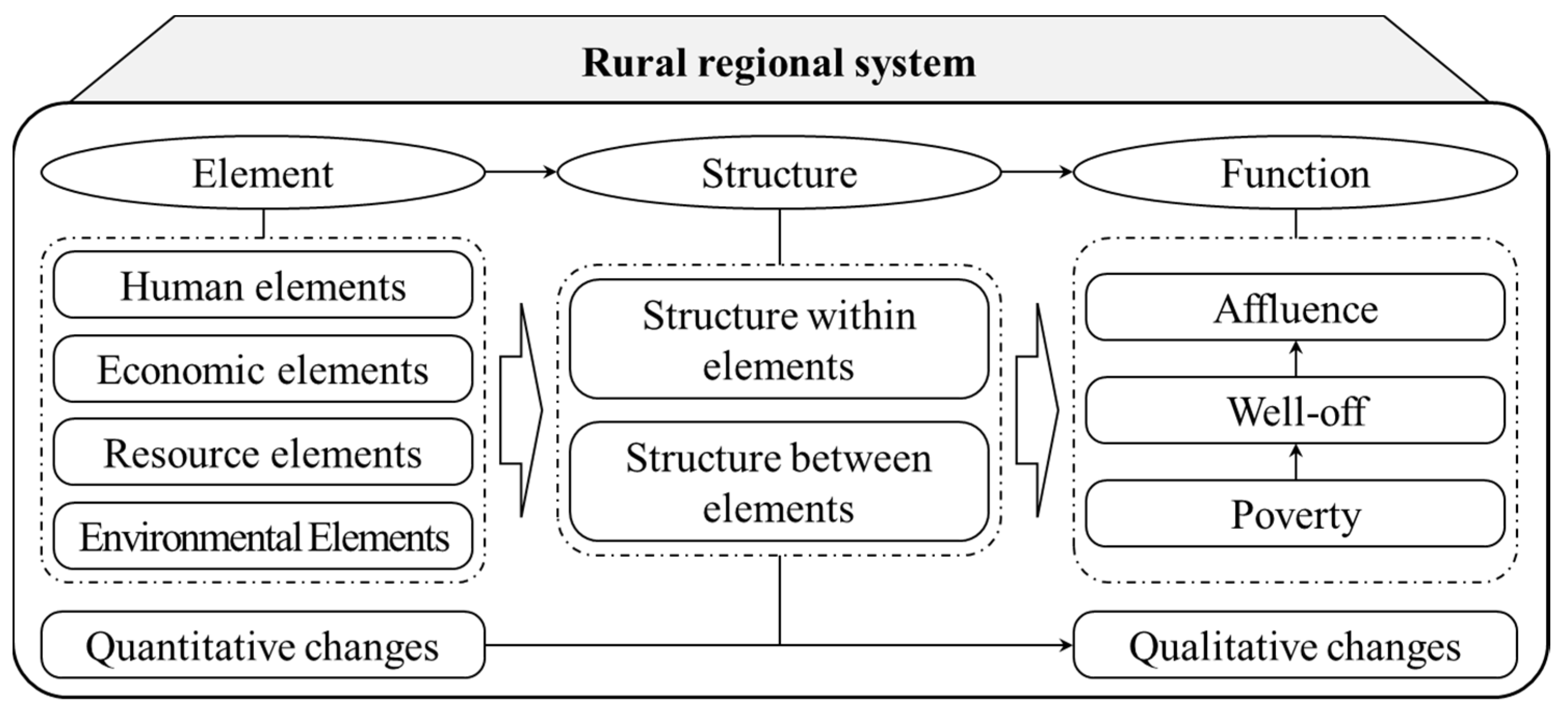
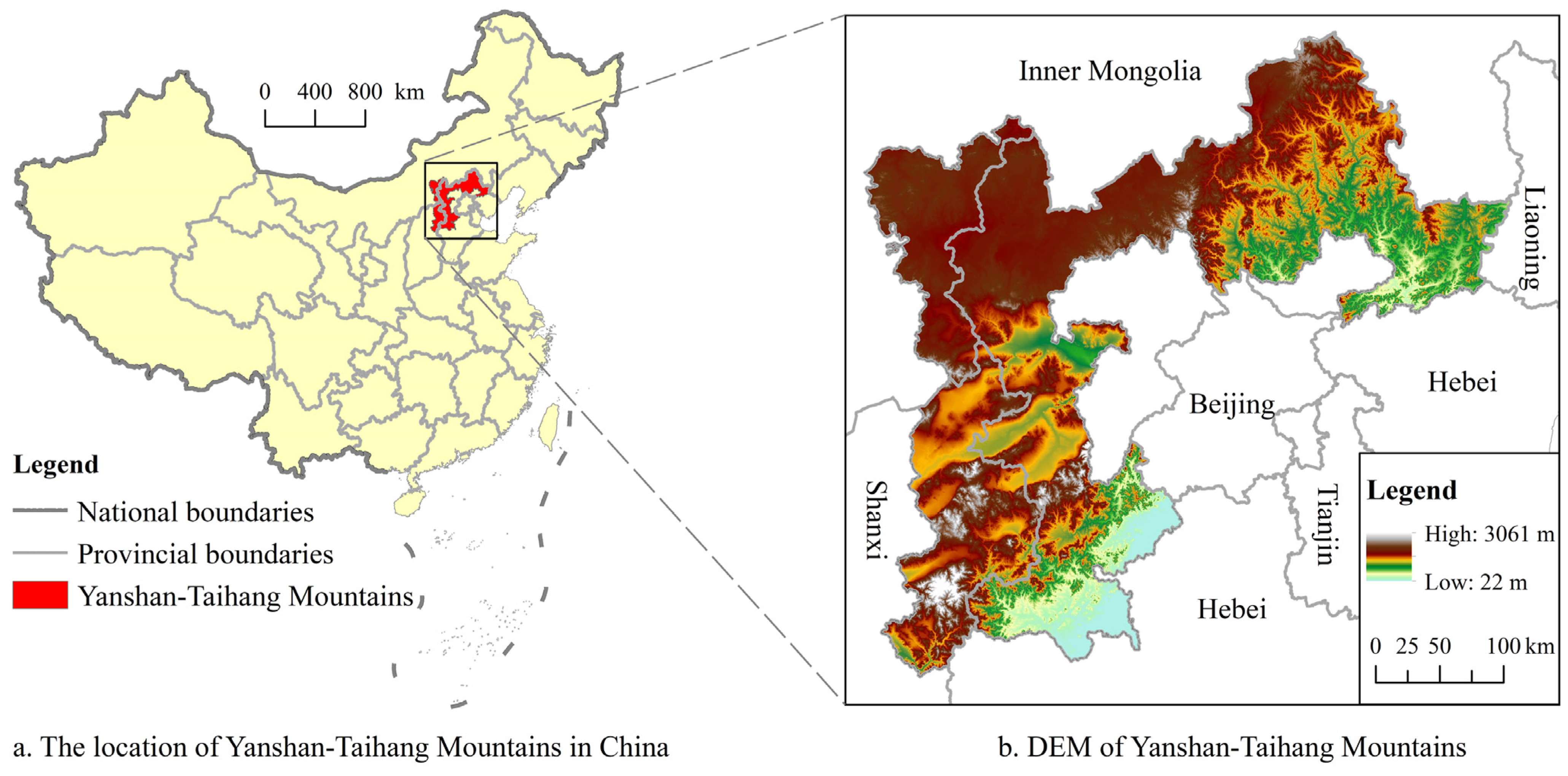
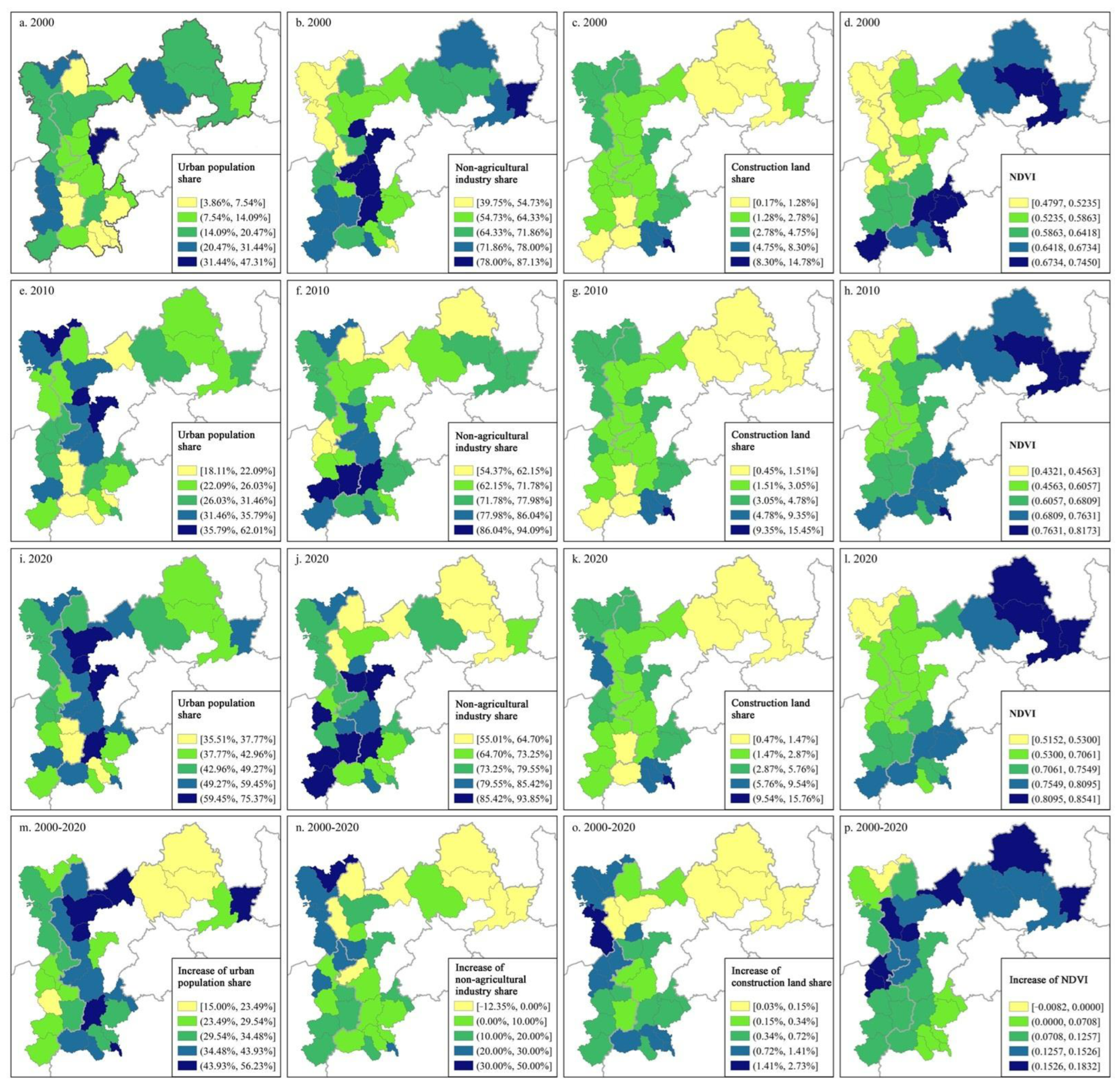

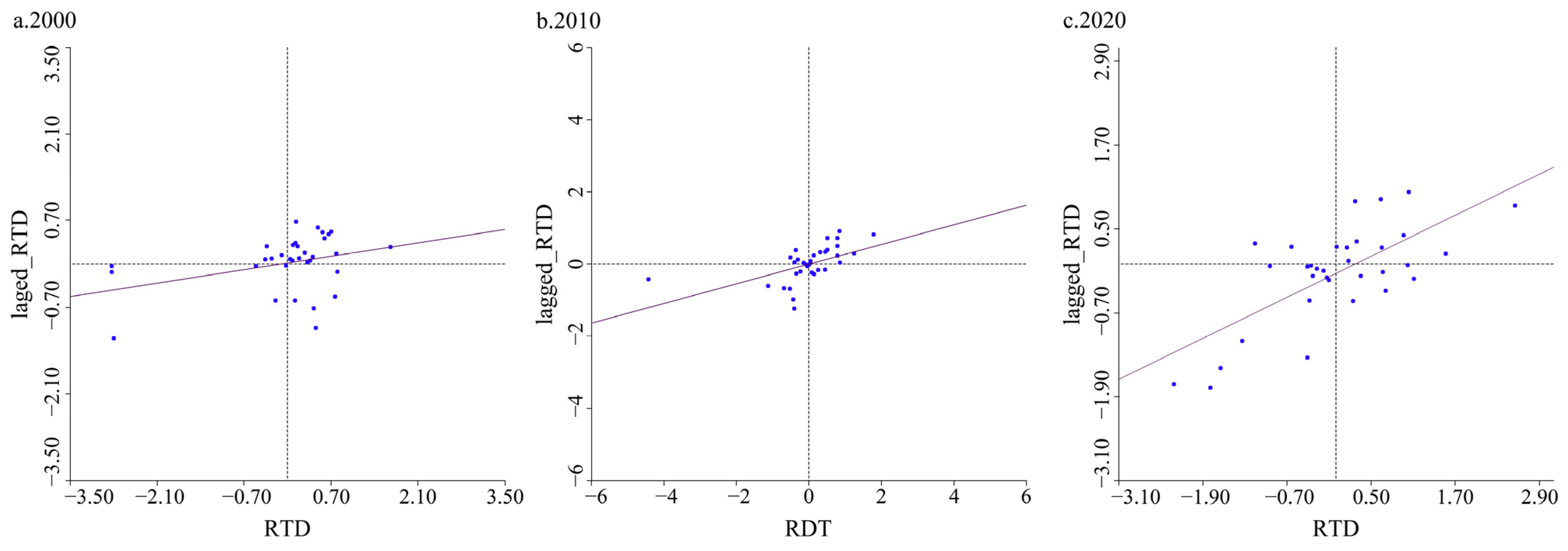
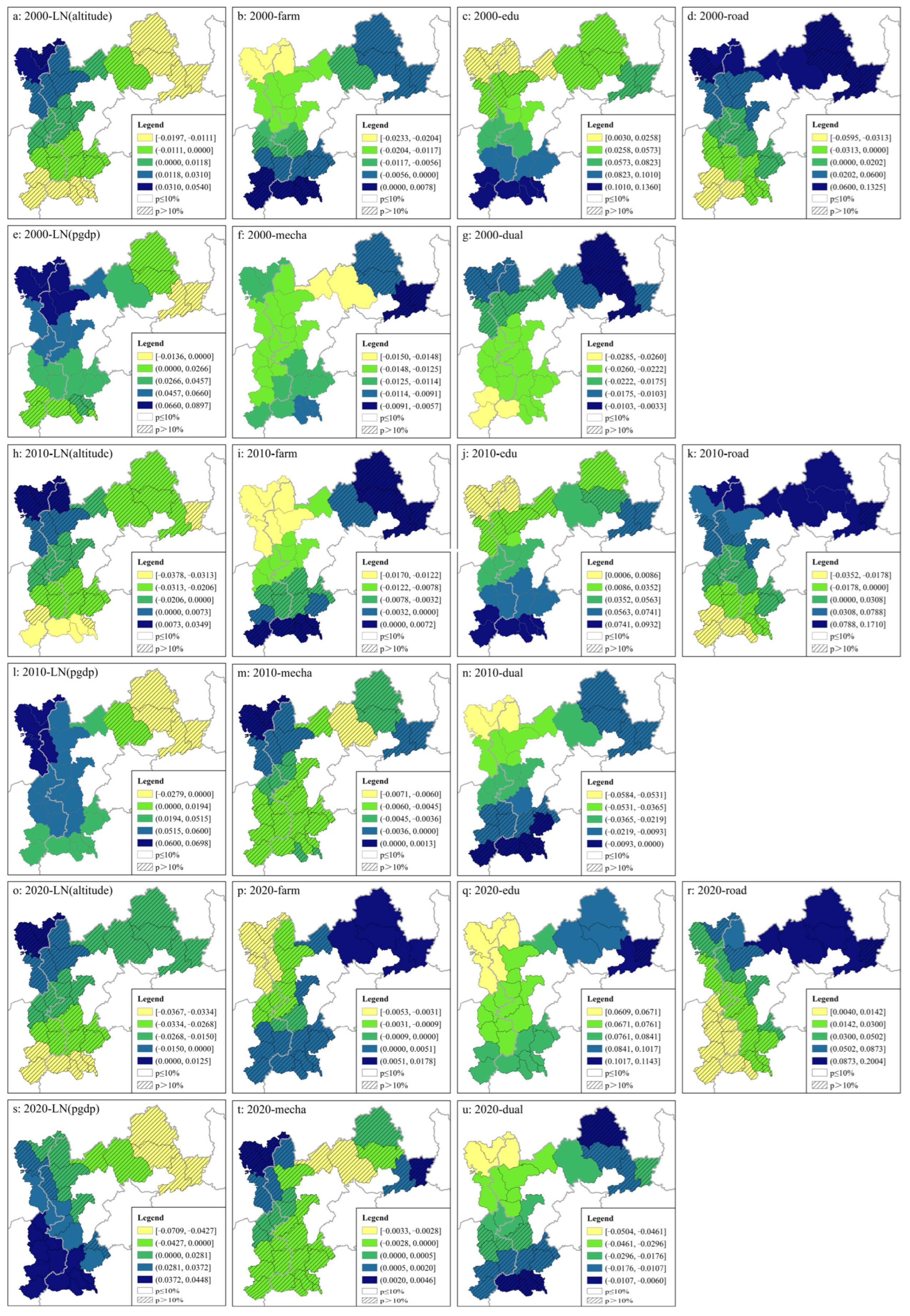
| Dimension | Indicator | Description |
|---|---|---|
| Human elements | Urban population share | Urban resident population/total resident population |
| Economic elements | Non-agricultural industry share | Added-value of secondary and tertiary industries/GDP |
| Resource elements | Construction land share | (Total of urban and rural residential areas, transportation, industrial and mining and other land)/total area of the region |
| Environmental elements | NDVI | An index reflecting the status of land vegetation cover |
| Variables | Description |
|---|---|
| Average altitude | The average value of DEM |
| Per capita farmland area | Total farmland area/Rural registered population |
| Average years of schooling | Average years of schooling for the resident population aged 6 and above |
| Road density | Total length of road/Total area of the region |
| Per capita GDP | GDP/Total resident population |
| Level of agricultural mechanization | Total power of agricultural machinery/Total sown area |
| Per capita income of rural households | Per capita disposable income of rural households |
| Urban–rural dual structure | Ratio of per capita disposable income of urban and rural households |
| Type | Indicator/Variable | Unit | Minimum | Maximum | Mean | Standard Deviation |
|---|---|---|---|---|---|---|
| Measurement indicators | Urban population share | % | 3.86% | 62.23% | 29.91% | 15.39% |
| Non-agricultural industry share | % | 39.75% | 94.09% | 72.87% | 10.94% | |
| Construction land share | % | 0.17% | 15.76% | 3.33% | 2.89% | |
| NDVI | - | 0.4321 | 0.8541 | 0.6687 | 0.0992 | |
| Pre-selected influencing factors | Average altitude | m | 44 | 1500 | 1044 | 426 |
| Per capita farmland area | mu/person | 0.65 | 11.44 | 3.73 | 2.53 | |
| Average years of schooling | year | 6.02 | 10.10 | 8.19 | 0.86 | |
| Road density | km/km2 | 0.0782 | 1.7014 | 0.5949 | 0.3217 | |
| Per capita GDP | yuan/person | 1369 | 83,402 | 16,632 | 15,094 | |
| Level of agricultural mechanization | kWh/ha | 0.60 | 17.37 | 4.85 | 3.07 | |
| Per capita income of rural households | yuan/person | 958 | 16,543 | 5536 | 4574 | |
| Urban–rural dual structure | - | 1.85 | 5.23 | 3.16 | 0.78 |
| 2020 | |||||||
|---|---|---|---|---|---|---|---|
| Imminent Disorder | Barely Coupling Coordination | Primary Coupling Coordination | Intermediate Coupling Coordination | Advanced Coupling Coordination | Total | ||
| 2000 | Primary coupling coordination | 1 | 1 | ||||
| Barely coupling coordination | 2 | 4 | 1 | 7 | |||
| Imminent disorder | 1 | 3 | 7 | 6 | 17 | ||
| Mild disorder | 1 | 4 | 5 | ||||
| Severe disorder | 2 | 1 | 3 | ||||
| Total | 1 | 4 | 15 | 11 | 2 | 33 | |
| Bandwidth | Residual Squares | Sigma | AIC | R2 | Adjusted R2 | Spatio-Temporal Distance Ratio | |
|---|---|---|---|---|---|---|---|
| GTWR | 0.2859 | 0.7762 | 0.0885 | −136.706 | 0.6814 | 0.6569 | 0.5418 |
| OLS | −140.1425 | 0.5035 |
Disclaimer/Publisher’s Note: The statements, opinions and data contained in all publications are solely those of the individual author(s) and contributor(s) and not of MDPI and/or the editor(s). MDPI and/or the editor(s) disclaim responsibility for any injury to people or property resulting from any ideas, methods, instructions or products referred to in the content. |
© 2023 by the authors. Licensee MDPI, Basel, Switzerland. This article is an open access article distributed under the terms and conditions of the Creative Commons Attribution (CC BY) license (https://creativecommons.org/licenses/by/4.0/).
Share and Cite
Guo, Y.; Zhong, W. Rural Transformation Development and Its Influencing Factors in China’s Poverty-Stricken Areas: A Case Study of Yanshan-Taihang Mountains. Land 2023, 12, 1080. https://doi.org/10.3390/land12051080
Guo Y, Zhong W. Rural Transformation Development and Its Influencing Factors in China’s Poverty-Stricken Areas: A Case Study of Yanshan-Taihang Mountains. Land. 2023; 12(5):1080. https://doi.org/10.3390/land12051080
Chicago/Turabian StyleGuo, Yuanzhi, and Wenyue Zhong. 2023. "Rural Transformation Development and Its Influencing Factors in China’s Poverty-Stricken Areas: A Case Study of Yanshan-Taihang Mountains" Land 12, no. 5: 1080. https://doi.org/10.3390/land12051080
APA StyleGuo, Y., & Zhong, W. (2023). Rural Transformation Development and Its Influencing Factors in China’s Poverty-Stricken Areas: A Case Study of Yanshan-Taihang Mountains. Land, 12(5), 1080. https://doi.org/10.3390/land12051080






